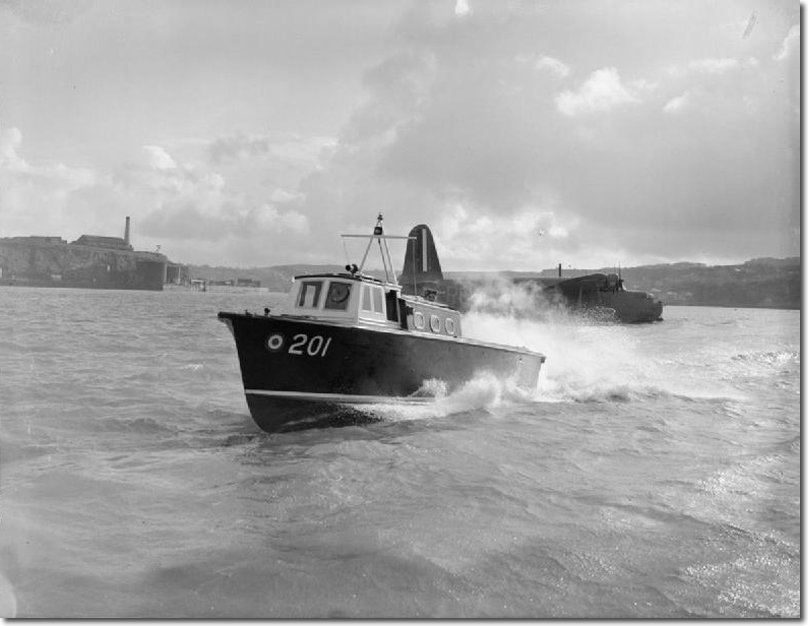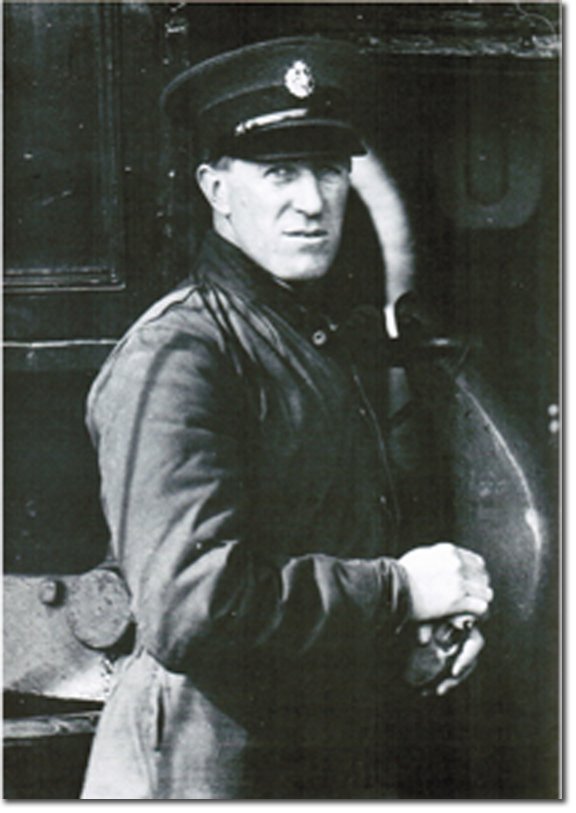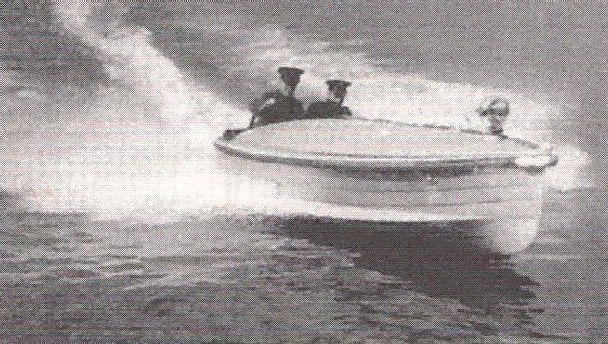Just about everybody has seen the film Lawrence of Arabia, which more or less correctly portrays T.E. Lawrence rushing around the dessert on a camel inspiring various Arab tribes to fight on behalf of the British in the First World War. At the end of the film the impression is given that shortly after the War ended, Lawrence returned to England and was killed in a motor bike accident. His accidental death is true, but it happened some 17 years after he returned from the War, and in the intervening time he had another, little known career in the Marine Branch of the R.A.F. where he was instrumental in developing the R.A.F’s fast rescue boats, which in the end saved some 13000 lives.

In 1925 Lawrence joined the Marine Branch at R.A.F. Mountbatten in Plymouth under the assumed name of T.E. Shaw. The Base Commander, was Wing Commander Sydney Smith, a long time friend of Lawrence who gave him a job working with a civilian Hubert Scott-Paine to develop and test what later became the R.A.F’s famous ‘crash boats’ immortalized in the book and film, The Sea Shall Not Have Them, which was also their motto. Lawrence was deeply interested in this project as he had witnessed at first hand a sea plane crash in 1931 and was horrified at the slowness of the boats sent out to the scene, which meant that all of the crew drowned long before any of the rescue boats arrived.

All of these boats were based on Navy boats which had to do a completely different job and were obviously so inadequate (Lawrence called them ‘dull stupid heavy motorboats’) that Lawrence lobbied the Station C.O. to replace their slow boats with faster planning boats. These were quite rare and new-fangled, but Lawrence had had some experience of them whilst assisting with the 1929 Schneider Trophy. The tender to the yacht that Lawrence had stayed on at that time was a Biscayne Baby Launch which although fast, had temperamental engines which Lawrence showed a remarkable aptitude to keep running, so the owner gave the Launch to him as a present.

Hubert Scott-Paine was one of the most famous people in the world of powerboat racing and marine aviation. He had managed the Supermarine factory in Southampton and in hiring R.J. Mitchell (of Spitfire fame) he managed to win the Schneider Trophy in 1922. Scott-Paine then set up the British Powerboat Company which by 1931 had built the fastest boat in the world, Miss England 11 which set a new world water speed record of 98.7 m.p.h. and later raised this to 111m.p.h. While all this was going on Scott-Paine had also made an offer to build a 35ft planning launch for the R.A.F. The man dealing with this for the R.A.F. was Flight Lt. W.E.G. Beauforte-Greenwood and it was he who suggested to Scott-Paine that Lawrence would be the ideal person to conduct the trials and development of these boats. The R.A.F. initially wanted 40ft boats but Scott-Paine preferred a length of 35ft. in the end a compromise was made and they started with a 37ft 6 inch craft. The result was the rather doubtful sounding 200 Class Seaplane Tender which was in fact a very fast motor launch. constructed of diagonally planked mahogany, a single layer on her topside with the rest of the hull made of a double layer to give strength. She was powered by two 100 HP Masons engines which gave her a top speed of some 36 knots.


The testing of this boat took up most of Lawrence’s time at Mount Batten because a lot of the work was in unknown territory and the engines had to be made to be reliable a sustained high speeds. Lawrence was self-taught and by now well respected for his marine knowledge and practical application. He was invited to write the official handbook for the RAF ST 200-class speedboats and the handbook today remains perhaps the most concise and instructive technical manual ever published. It was still in use until well after World War II. In 1933 Lawrence left Mount Batten to take up his duties at the RAF Marine Aircraft Experimental Establishment at RAF Felixstowe. Two years later he was killed in a motorbike accident near his home at Clouds Hill. You can see one of the boats that Lawrence worked on at the R.A.F. Museum in Hendon.

Leslie James Payne says
I DID know about ‘Lawrence’ and his involvement with the RAF Marine Section! Fortunately for me, I was on vacation in Madeira, in the Capital City of Funchal, there is a Sky-Lift. At the bottom is a rather large glass display-case, in which is one of the ‘Lawrence’ inspired Air-Sea Rescue launches. There is also a ‘Legend’ on display, as to how these launches were designed by ‘Lawrence’ and, that they were used by the Airport? to transfer passengers from the ‘Flying-Boats’ which were the only way for holiday-makers to access the island.
My former ‘Metalwork Teacher’ was an Engineer on these craft during the WWII and he used to tell us a little about the roar of the engines and the speed of the boats! I WAS inpressed!
Since moving to Plymouth and driving between Plymouth and Modbury. I have seen one of these craft under a Green-Tarpaulin,alongside the Blacksmiths Shop between Brixton and Yealmpton on the south side of the road,on the right heading out from Brixton. Some 5 years ago it was lying ready for restoration. I do hope that Chris the Blacksmith has had some assistance in this? I now live in Liskeard, Cornwall and think it is too far a distance to travel, to be involved in the project.
Submerged Comment says
Peter Samain (peter.samain@gmail.com) wrote:
Having just visited the Norfolk and Suffolk Aviation Museum (where there is a hut dedicated to the RAF fast launches), I came across this email.
If there is anything being done to save this launch – please let me know – if I can help – I will
Yours
Peter Samain
Submerged Comment says
Rodney Newton (carl@c2-concept.com) wrote:
I have just found your post about the fast rescue boat just outside Yealmpton.
Like you we drive past the boat most days and we know the property were it is stored is for sale and possibly been sold.
We have spoken to the agents and they have said the boat is not included in the sale and if the owners can’t be identified they will have no option but to cut the boat up to get rid of it.
We have just contacted the National Maritime Museum in Falmouth to see if they could restore the boat in conjunction with Falmouth Marine School. I expect there would be no shortage of community support as these boats saved over 13,000 lives during there conception..
dave solomon says
I Was At One Time In The 70s Stationed at Mt Batten As a Transport Drive Lawrence Lived On, On The Base With The Only Police Dog Being Called . ” Shaw “
Jon Davis says
Hello interested parties
I when boating with my cousin was introduced to one of these wonderful craft of which there were many variations (discovered at later dates)my uncles was a 41ft 6in seaplane tender with two Meadows petrol engines.The other was a boat we used to cruise the Bristol channel and that was a Air sea rescue launch 68ft with three Rolls Royce V12 Merlin marine engines which after several trips it was decided to take them out and replace them with two marinized AEC DIESEL ENGINES.Ihad many pleasant times aboard her and was told a few years ago that she was last seen in Barry docks.
when I sailed on her she was still inher Royal naval finish.
Regards
Jon Davis
Bill Humble says
I moved back to R.A.F.Mt.Batten in 1946 as a 9yr.old. We had briefly lived there on our return from Malta GC.before the 2nd WW. As kids we had great fun playing on many of the launches and larger HSL’s The airmen at that time were very relaxed, and allowed us much freedom. We even got to taxi in a Sea Otter, and allowed to sit in Sunderlands on the water and in the hangers. Oh what fantastic memories. Of course I eventually went on to join the R.A.F. as a Locking App. in 1953. Very happy days. Cheers.
Don says
3021, a picture of a craft used by 201 Squadron with my Dad getting off in 43/44. Can someone possibly identify which model & where this one was please ? Also, my link to Laurence of Arabia is further extended by a photo of me, in 1991 in a place called Tabuk (not Tabruk), in the middle of the desert on top of a certain steam train that TE Laurence had blown off its tracks in WW1. I was with Tornado and Bucanneer squadrons – any one any photos of 201, or the boats or crews from Castle Archdale or Pembroke Dock please get in touch. Dad was AH Howat, (skippers Bent & Baveystock). Thanks Don.
Susan says
Thanks for this bit of history.
When holidaying near Mount Batten in the 80s I noticed a blue plaque on the wall outside a house called ‘Crows Nest’ (opposite the Mt Batten gates) which states that TE Shaw lived there. I have never seen mention of his presence there, or the reason for it, in any accounts of his life so this piece is most interesting. Strange that such important work has been edited out of so many biogs of such a varied life.
Kerry jones says
I have come into possession of which I believe is an old seaplane tender or rescue launch it has a number across the main bulkhead which is o n 302 682 if anyone has any information about this craft or could steer me in the right direction to find out it’s history it would be very much appreciated
j.williams says
My in -law wants to build a working model of Lawrence’s craft, please is there any drawings my in-law could buy ? , he saw a craft RAF Hendon , he told me that it was a prince class, 68 RTTL, I hope you can help me, thank you.
phil goddard says
Hi ,I’ve built a raf fire boat and would like to give it a name, it’s the number 94 vosper launch scale1/24 a very lovely craft ,what would be appropriate, if anything, Regards P Goddard
Brian Mccauley aka Paddy says
Thanks great article, I joined the MCS 1953 served 27yrs and my first instructor was Tommy Jorden who knew AC Shaw at Mt Batten/ Calshot.
Ian Haigh says
Not quite in period for article but of interest re: T.E. Lawrence, just before his RAF Mountbatten time.
I am currently reading ‘Flying and Soldiering’ by 2nd Lieut. R.R. Money, (1st Ed., 1936, Ivor Nicholson & Watson, London .) As per title, it is a fascinating account of the author’s experiences during the period 1915-1926 – which he wrote up in 1935, the year of Lawrence’s death. It’s a somewhat understated story of life in the RFC (inc. as a PoW), in the Army (post WWI, in Ireland) and then in the FAA (1922 -26), and I can recommend it. On page 222, I came across this little (delightfully disdainful?) snippet.
‘In January 1924, the Fighter and Reconnaissance Service Flights left Leuchars for Gosport (the shore base for embarkation in HMS Argus), … [he then notes his difficulties with limited resources prior to carrying out training exercises on carrier flying operations ]
… With misguided enthusiasm, I drew attention to our lack of personnel and consequently acquired from a grudging Workshop’s officer three each of his less-than-valuable riggers and fitters, the senior of whom was the never-to-be-forgotten Bolshevik-minded Leading Aircraftsman called Shaw. With these men and the eager but comparatively useless assistant pupil officers, we succeeded in changing the engine in the Avro….’
Obviously, Colonel Lawrence – he of ‘Seven Pillars of Wisdom’ and (especially) ‘The Mint’ fame – made an impression on 2nd Lieut Money … possibly he found LAC Shaw a bit erksome!
Mark says
My grandfather William Henry Hunter befriended Lawrence during his time with the RAF in both Mount Batten and Felixstowe
Apparently they used to often meet for morning tea on both stations according to my father’s memories
When Lawrence left the MAEE at Felixstowe he according to family history gifted my grandfather a brass light stand and some books